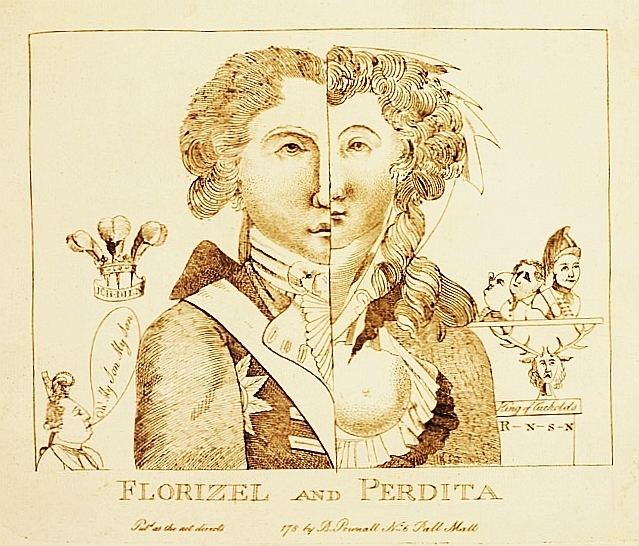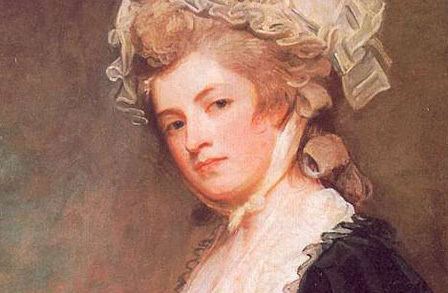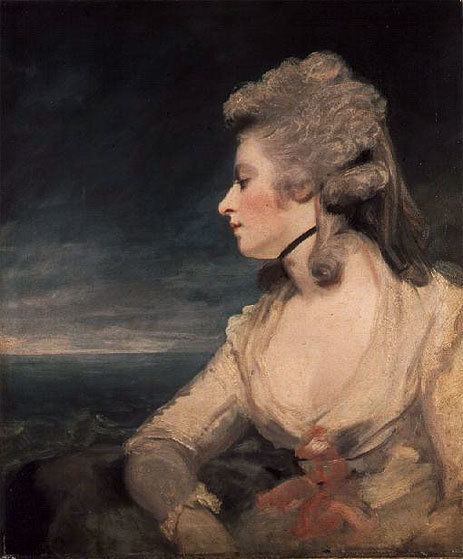Full Name Mary Robinson Name Mary Robinson | Role Actress | |
 | ||
Born 27 November 1757 ( 1757-11-27 ) England Died December 26, 1800, England, United Kingdom Books Letter to the Women of Englan, Sappho and Phaon: In a Serie, Poems (1791) (Dodo Pr, Walsingham - Or - The Pupil of N, Sappho and Phaon | ||
Mary robinson a tribute to an amazing irish woman
Mary Robinson (née Darby; 27 November 1757? – 26 December 1800) was an English actress, poet, dramatist, novelist, and celebrity figure. During her lifetime she was known as "the English Sappho". She earned her nickname "Perdita" for her role as Perdita (heroine of Shakespeare's The Winter's Tale) in 1779. She was the first public mistress of King George IV while he was still Prince of Wales.
Contents
- Mary robinson a tribute to an amazing irish woman
- Saturday night with miriam mary robinson interview
- Early life
- Marriage
- Theatre
- Later life and death
- Literature
- Poetry
- Criticism and Reception
- Novels
- Dramas
- Socio political texts
- Memoir
- Biographies of Robinson
- Resources on Robinson and her literature
- Fictional works about Robinson
- References

Saturday night with miriam mary robinson interview
Early life

Robinson was born in Bristol, England to Nicholas Darby, a naval captain, and his wife Hester (née Vanacott) who had married at Donyat, Somerset, in 1749, and was baptised 'Polle' at St Augustine, Bristol, 19 July 1758, the entry noting that she was born 27 November 1756. In her memoirs, Robinson gives her birth in 1758 but the year 1757 seems more likely according to recently published research (see appendix to Byrne, 2005). Her father deserted her mother and took on a mistress when Robinson was still a child. The family hoped for a reconciliation, but Captain Darby made it clear that this was not going to happen. Without the support of her husband, Hester Darby supported herself and the five children born of the marriage by starting a school for young girls in Little Chelsea, London, (where Robinson taught by her 14th birthday). However, during one of his brief returns to the family, Captain Darby had the school closed (which he was entitled to do by English law). Darby died in the Russian naval service in 1785. Robinson, who at one point attended a school run by the social reformer Hannah More, came to the attention of actor David Garrick.
Marriage

Hester Darby encouraged her daughter to accept the proposal of an articled clerk, Thomas Robinson, who claimed to have an inheritance. Mary was against this idea; however, after being stricken ill, and watching him take care of her and her younger brother, she felt that she owed him, and she did not want to disappoint her mother who was pushing for the engagement. After the early marriage, Robinson discovered that her husband did not have an inheritance. He continued to live an elaborate lifestyle, however, and had multiple affairs that he made no effort to hide. Subsequently, Mary supported their family. After her husband squandered their money, the couple fled to Talgarth, Wales (where Robinson's only daughter, Mary Elizabeth, was born in November). Here they lived in a fairly large estate, called Tregunter Park. Eventually Her husband was imprisoned for debt in the Fleet Prison where she accompanied him for many months. During this time, Mary Robinson found a patron in Georgiana Cavendish, Duchess of Devonshire, who sponsored the publication of Robinson's first volume of poems, Captivity.
Theatre

After her husband obtained his release from prison, Robinson decided to return to the theatre. She launched her acting career and took to the stage, playing Juliet, at Drury Lane Theatre in December 1776. Robinson was best known for her facility with the 'breeches parts', her performances as Viola in William Shakespeare'sTwelfth Night and Rosalind in As You Like It won her extensive praise. But she gained popularity with playing in Florizel and Perdita, an adaptation of Shakespeare, with the role of Perdita (heroine of The Winter's Tale) in 1779. It was during this performance that she attracted the notice of the young Prince of Wales, later King George IV of the United Kingdom. He offered her twenty thousand pounds to become his mistress. With her new social prominence, Robinson became a trend-setter in London, introducing a loose, flowing muslin style of gown based upon Grecian statuary that became known as the Perdita. It took Robinson a considerable amount of time to decide to leave her husband for the Prince, as she did not want to be seen by the public as that type of woman. Throughout much of her life she struggled to live in the public eye and also to stay true to the values in which she believed. She eventually gave in to her desires to be with a man whom she thought would treat her better than Mr. Robinson. However, the Prince ended the affair in 1781, refusing to pay the promised sum. "Perdita" Robinson was left to support herself through an annuity promised by the Crown (but rarely paid), in return for some letters written by the Prince, and through her writings.
Later life and death
Mary Robinson, who now lived separately from her husband, went on to have several love affairs, most notably with Banastre Tarleton, a soldier who had recently distinguished himself fighting in the American War of Independence. Their relationship survived for the next 15 years, through Tarleton's rise in military rank and his concomitant political successes, through Mary's own various illnesses, through financial vicissitudes and the efforts of Tarleton's own family to end the relationship. They had no children, although Robinson had a miscarriage. However, in the end, Tarleton married Susan Bertie, an heiress and an illegitimate daughter of the young 4th Duke of Ancaster, and niece of his sisters Lady Willoughby de Eresby and Lady Cholmondeley. In 1783, Robinson suffered a mysterious illness that left her partially paralysed. Biographer Paula Byrne speculates that a streptococcal infection resulting from a miscarriage led to a severe rheumatic fever that left her disabled for the rest of her life. From the late 1780s, Robinson became distinguished for her poetry and was called "the English Sappho". In addition to poems, she wrote eight novels, three plays, feminist treatises, and an autobiographical manuscript that was incomplete at the time of her death. Like her contemporary Mary Wollstonecraft, she championed the rights of women and was an ardent supporter of the French Revolution. She died in poverty at Englefield Cottage, Englefield Green, Surrey, 26 December 1800, aged 44, having survived several years of ill health, and was survived by her daughter, Maria Elizabeth (1774-1818), who was also a published novelist. Administration of her estate was granted to her husband Thomas Robinson from whom she had long been separated and who in 1803 inherited a substantial estate from his half-brother William.
Literature
In 1792 Robinson published her most popular novel which was a Gothic novel titled, Vancenza; or The Dangers of Credulity. The books was "sold out by lunch time on the first day and five more editions quickly followed, making it one of the top-selling novels in the latter part of the eighteenth century." It did not receive either critical or popular acclaim. In 1794 she wroteThe Widow; or, A Picture of Modern Times which portrayed themes of manners in the fashionable world. Since Robinson was a fashion icon and very much involved in the fashion world the novel did not get a lot of favorable reception in 1794 as it might have now. In 1796 she wrote Angelina; A Novel, it costed more money than it brought in. Through this novel, she offers her thoughts on the afterlife of her literary career. After years of scholarly neglect, Robinson's literary afterlife continues apace. While most of the early literature written about Robinson focused on her sexuality, emphasizing her affairs and fashions, she began to receive the attention of feminists and literary scholars in the 1990s. In addition to regaining literary and cultural notability, she has re-attained a degree of celebrity in recent years when several biographies of her appeared, including one by Paula Byrne entitled Perdita: The Literary, Theatrical, and Scandalous Life of Mary Robinson that became a top-ten best-seller after being selected for the Richard & Judy Book Club. An eight-volume scholarly edition of Robinson's complete works was published in 2009-2010. In 2011, Daniel Robinson (no relation), editor of the poetry for the edition, published the first scholarly monograph to focus exclusively on her literary achievement--The Poetry of Mary Robinson: Form and Fame. A second monograph on Robinson's literary career, Mary Robinson and the Genesis of Romanticism: Literary Dialogues and Debts, 1784-1821, by Ashley Cross, appeared in 2016. Although, Robinson's novels were not as successful as she hoped, she had a talent for her poetry.
Poetry
From the late 1780s, Robinson became distinguished for her poetry and was called "the English Sappho." In addition to poems, she wrote eight novels, three plays, feminist treatises, and an autobiographical manuscript that was incomplete at the time of her death. The Poems of 1775 was published, while Robinson’s husband was in prison. Then she published a poem in 1777, which was simply titled Captivity; a poem and Celadon and Lydia, a Tale. The subject matter in this poem was influenced by a situation with Robinson's husband Thomas Robinson and Lord Lyttleton. According, to Robinson's Memoirs, Lord Lyttleton was not concerned with the marital status of Robinson revealed that her husband had a mistress. Later it was proved to be true among other multitudes of lies that unraveled and consequently lands himself in Jail for debt. Robinson's affair was broadcast and was the center of town gossip and many believed the scandal that encompassed her significantly undermined her literature's worth. Robinson was on her way to establishing a new poetic identity for herself, when she let go of her Della Cruscan style when she wrote the Poems volumes published in 1791 and 1793. A review was written by the Gentleman's Magazine and the reviewer stated that if Robinson had been less blessed with "beauty and captivating manners","her poetical taste might have been confined in it's influence" and at the end of the review describes her poetry as elegant and harmonious. In 1795, Robinson wrote a satirical poem titled London's Summer Morning. This poem showcased Robinson's critical perspective of the infrastructure and society of London. Robinson describes the busy and loud sounds of the industrialized city in the morning. She employs characters such as the chimney-boy, and ruddy housemaid to make a heavy critic on the way society treats children as innocent fragile creatures. In 1796 Robinson argues eloquently for women's rationality and right to education and illustrates ideas of free will, suicide, rationalization, empiricism and relationship to sensibility in Sappho and Phaon: In a Series of Legitimate Sonnets. She was an ardent admirer of Mary Wollstonecraft, and her Letter to the Women of England against Mental Subordination still makes powerful reading." Robinson reiterates the rights women have to live by sexual passion. Lastly, In 1800 she writes a series of poems titled the Lyrical Tales, which explores themes of domestic violence, misogyny, violence against destitute characters, and political oppression. Robinson's main objective was to respond to Lyrical Ballads written by authors Wordsworth and Coleridge; who were not as well known at the time.
Criticism and Reception
Robinson was known as a sexualized celebrity, but she was a very talented writer. Robinson didn't receive recognition for her work until much later because of "strict attitudes led to a rejection of the literary work of such a notorious woman." She became a lesson to young girls about the dangers of promiscuity, and pleasure seeking. She was named by friend Samuel Taylor Coleridge "as a woman of undoubted genius." The collection of Poems published in 1791 had a "subscription list of 600 people was headed by His Royal Highness, George, Prince of Wales, and included many other members of the nobility. Some people subscribed because of her writing, some because of her notoriety, and some perhaps out of pity for the former actress, now crippled and ill. Reviews were generally kind, and noted traces in her poems of a sensibility that would later be termed Romanticism." Twenty years after her death the Poetical Works of The Late Mrs. Robinson was published in 1824, which speaks to her ongoing popularity. Robinson's second novel The Widow, and in her controversial comedy Nobody: A Comedy in Two Acts both of which, according to newspaper reports, offended fashionable women. Needless to say, Robinson's playwright career was short-lived after all the bad reviews of her play. The upper class interpreted her satire as mockery on female gambling and it was an attack on moral legitimacy of the Whig elite. The upper class interpretation of Nobody reveals a great deal about the social and political anxieties during the revolutionary era. Robinson's poems were popular, especially after she produced a variety of poems, while working at the newspaper the Morning Post. The poetry columns had a double agenda of pleasing a substantial and diverse audience and shaping them into a select group of elite readers eager to buy and consume books. The public adored the novel Vancenza; or The Dangers of Credulity, but the critical reception was mixed. Furthermore, a biographer Paula Byrne recently dismissed it as a “product of the vogue for Gothic fiction [that] now seems overblown to the point of absurdity.” Although, Robinson's poetry was more popular than her other works the most lucrative "was her prose. The money helped to support herself, her mother and daughter, and often Banastre Tarleton. Novels such as Vancenza (1792), The Widow (1794), Angelina (1796), and Walsingham (1797) went through multiple editions and were often translated into French and German. They owed part of their popularity to their suspected autobiographical elements. Even when her characters were placed in scenes of gothic horror, their views could be related to the experiences of their author."
